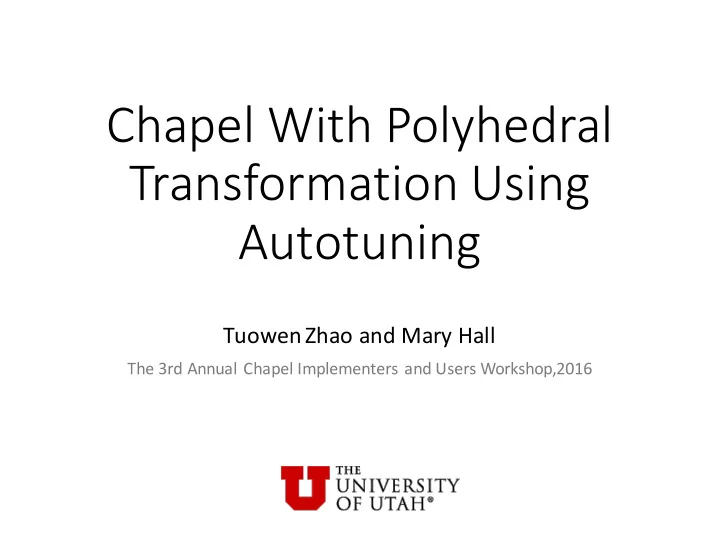

Chapel With Polyhedral Transformation Using Autotuning TuowenZhao and Mary Hall The 3rd Annual Chapel Implementers and Users Workshop,2016
Loop Transformation • Manipulation of loop nest • Structure • Schedule • Prior work: manually apply loop transformations in Chapel • I. J. Bertolacci et al. Parameterized diamond tiling for stencil computations with Chapel parallel iterators. ICS 2015 • A. Sharma et al. Affine loop optimization based on modulo unrolling in Chapel. PGAS 2014 • We: Automatically applied loop transformations using recipes from script which enables integration with autotuning framework
Contribution • Uses C code to capture sequential computation • Generates Chapel programs by composing polyhedral transformations on the sequential computation and mapping from iteration spaces to Chapel domains and iterator • Demonstrates with a simple example in Chapel the benefits of applying such transformations in conjunction with autotuning
Chapel Language proc mm(A:[] real ,B:[] real , an: int ,ambn: int ,bm: int ){ const D = {0..an-1, 0..bm-1}; // Domain var C : [D] real ; // Domain mapped array forall (i,j) in D do { // Iterator C[i,j] = 0; for k in {0..ambn-1} do C[i, j] += A[i, k] * B[k,j]; } return C; }
Polyhedral Framework • Iteration Spaces • A set of iteration vectors represented as integer tuples • Direct mapping from Chapel domain • Transformation done by linear mapping • Affine loop bounds, conditional expressions, array subscripts
Dependence analysis • Ensure validity of transformation and correctness of program • Have to know the order of references to each array elements • Cannot be applied to Chapel iterator without programmer intervention or runtime information
CHiLL • Composable High-Level Loop transformation framework • A polyhedral transformation and code generation framework • Relies on autotuning to generate highly-tuned implementations for a specific target architecture • Uses a transformation recipe to express optimization strategy (recipe may be generated by a compiler)
Architecture Overview
Experiment – matrix multiply • Input in C • Tile sizes {8; 16; 32; 64; 128; 256} for (i = 0; i < an; i++) • Distribution of the for (j = 0; j < bm; j++) initialization code { C[i][j]=0.0f; • Tile sizes for (n = 0; n < ambn; n++) • Chapel’s configuration variable C[i][j] += A[i][n] * B[n][j]; • Literal constant } • Intel Haswell i7-4790K • 16GB DDR3 RAM
Result
Stencil Computations • Operations on structured grids • MiniGMG • Geometric multigrid benchmark • Uses stencil computations extensively especially in smooth and residual operators • CHiLL on MiniGMG • P. Basu (2015) Compiler Optimizations and Autotuning for Stencils and Geometric Multigrid. PhD thesis. University of Utah
Stencil Optimizations • Communication avoiding optimizations • Wavefront(loop fusing) • Deeper ghost zones with redundant computation
User-defined library • StencilDist library • Problems • Can’t guarantee correctness(dependence) • Handwrite optimized code • Generality concern
Multi-locale Stencil
Multi-locale Stencil
Multi-locale Stencil • Programmer writes simple serial code fragments • Recipes provided by programmer or generated by autotuner • Behind-the-scene generation of distributed computation and distributed data • Produce fine-tuned code without programmer’s rewriting
Conclusion • Integrating Chapel with CHiLL • Instantly enables a lot of different optimization techniques that can be composed in complex sequences • Autotuningcan be used to find the best performing combination of transformations under target architecture Future work • Expanding the domain of autotuning by generating and tuning domain maps and iterators • Relaxing the transformation requirements by generalize to non-affine loop bounds and subscripts that employ indirection through an index array
Questions?
Recommend
More recommend